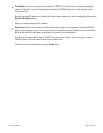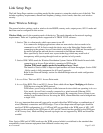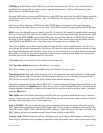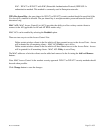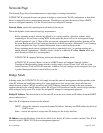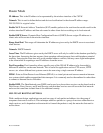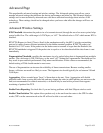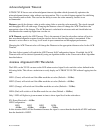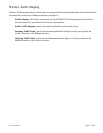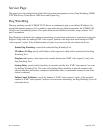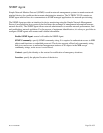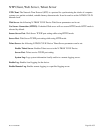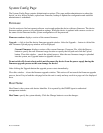Revision 04062009 Page 34 of 52
Router Mode
IP Address: This is the IP address to be represented by the wireless interface of the 702-W.
Netmask: This is used to define the host and device classification for the chosen IP address range.
255.255.255.0 is a typical value.
Enable NAT: Network Address Translation (NAT) enables packets to be sent from the outside world to the
wireless interface IP address and then sub-routed to other client devices residing on its local network.
Enable DHCP Server: Dynamic Host Configuration Protocol (DHCP) Server assigns IP addresses to
clients who will associate to the wireless interface.
Range Start/End: This range will determine the IP addresses given out by the DHCP server to associated
client devices.
Netmask: DHCP Netmask
Lease Time: The IP addresses given out by the DHCP server will only be valid for the duration specified by
the lease time. Increasing the time ensures client operation without interrupt, but could introduce potential
conflicts. Lowering the lease time will avoid potential address conflicts, but may cause slight interruptions
to the client while re-acquiring a new IP addresses from the server.
Port Forwarding: Port forwarding allows specific ports of the WLAN IP address to be forwarded to
different IP addresses on the same network. This is useful for applications such as FTP servers, HTTP
servers, etc. where different host systems want to be seen using a single common IP address.
PPPoE: Point-to-Point Protocol over Ethernet (PPPoE) is a virtual private and secure connection between
two systems which enables encapsulated data transport. It is commonly used as the medium for subscribers
to connect to Internet Service Providers.
Enable DMZ: The Demilitarized zone (DMZ) can be used as a place where services can be placed such as
Web Servers, Proxy Servers, and E-mail Servers such that these services can still serve the local network
and are at the same time isolated from it for additional security.
MULITCAST ROUTING SETTINGS
With a multicast design, applications can send one copy of each packet and address it to the group of
computers that want to receive it. This technique addresses packets to a group of receivers rather than to a
single receiver, and is dependent on the network to forward the packets to only the networks that need to
receive them.



